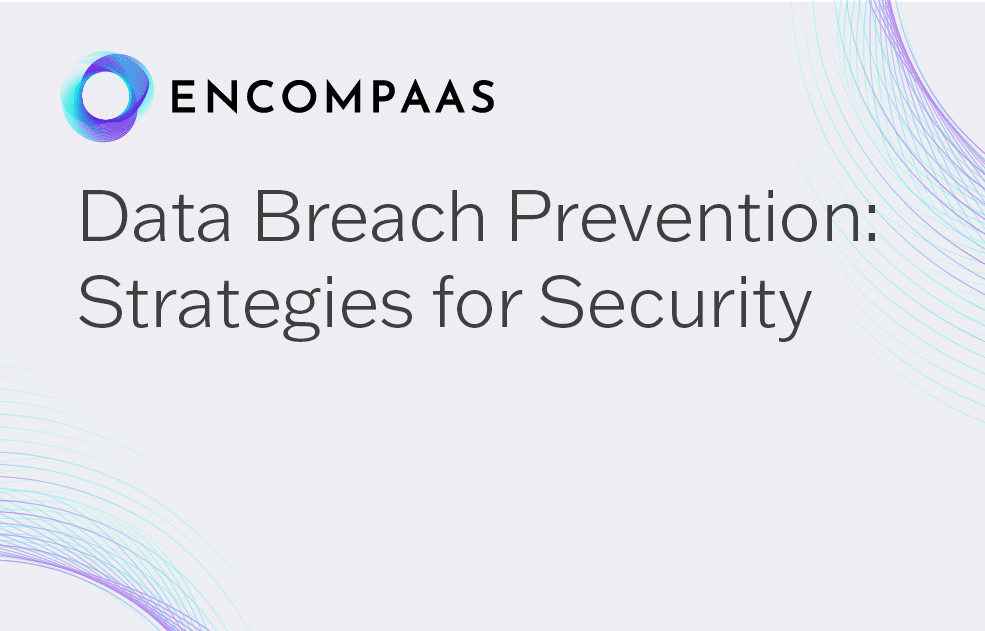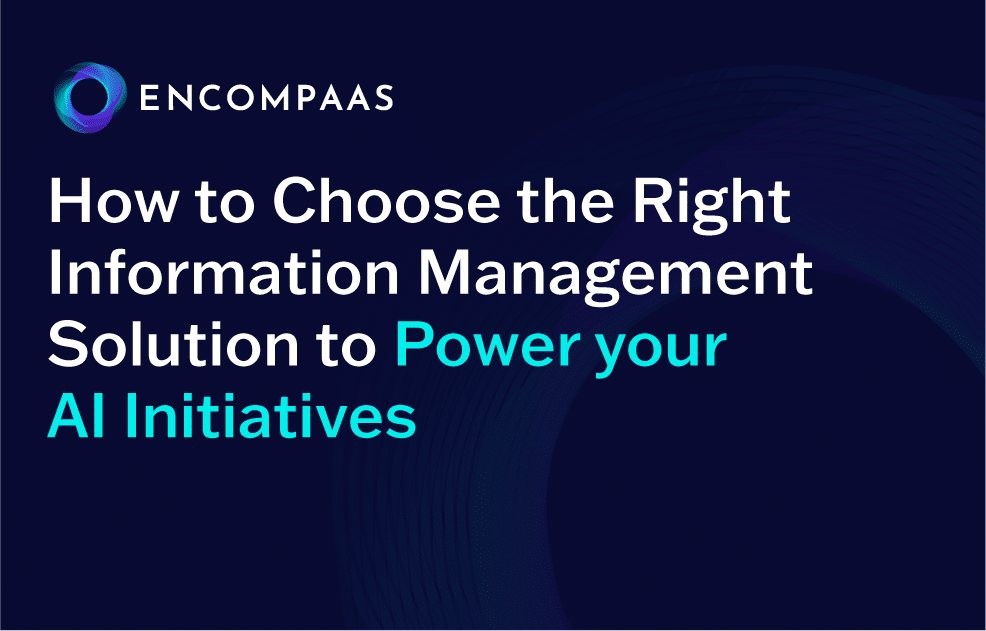Data breach prevention: 10 strategies for security
Authored by EncompaaS - Jan 1, 2023
Share

In today’s digital age, data holds the key to understanding customer behavior, developing innovative products, and maintaining a competitive edge. However, this valuable asset also makes organizations vulnerable to a significant threat: data breaches.
Data breaches occur when individuals within an organization gain unauthorized access to sensitive data, including customer data and the company’s financial records. These incidents can have devastating consequences, causing immense financial losses, reputational damage, and a decline in customer trust.
According to the IBM Cost of a Data Breach Report 2023, the global average data breach cost reached a staggering $4.45 million, with healthcare and financial services experiencing even higher costs. Hence, data breach prevention is necessary and critical, ensuring the seamless functioning of business operations in the long run.
This post examines how data breaches occur and the strategies to prevent them. We also demonstrate how tools like EncompaaS help secure your company against data breaches.
Main takeaways from this article:
- Data breaches can be catastrophic, leading to substantial financial losses, reputational damage, and loss of customer trust.
- Data breaches can result from physical security failures, cyber-attacks exploiting system vulnerabilities, and human errors like misdirected emails. These breaches typically involve unauthorized access to personal data, financial details, or corporate information.
- Key strategies to mitigate data breaches include strengthening access control systems, utilizing password managers, conducting regular security audits, encrypting sensitive data, and continuously monitoring suspicious activities.
- Educating employees on cybersecurity best practices and vigilantly managing third-party vendor risks are critical for preventing data breaches. Implementing multi-factor authentication and developing robust data security policies are also emphasized as essential practices.
- Establishing a comprehensive incident response plan, continuously monitoring network activities, and having an up-to-date data security policy are vital for quickly detecting and managing potential breaches, minimizing the overall impact on the organization.
What is a data breach?
A data breach is any incident where information is accessed and/or used without authorized permission. These breaches can occur in various forms:
- Physical breaches: Unauthorized access to physical storage devices containing sensitive data.
- Cyber breaches: This happens due to malicious attackers exploiting vulnerabilities in computer systems to access data.
- Accidental exposure: This refers to the inadvertent sharing of sensitive information through human error, such as sending an email to the wrong recipient.
The type of data compromised during a breach can vary depending on the attacker’s target. Commonly targeted information includes:
- Personal information: Names, addresses, Social Security numbers, and other identifying data.
- Financial details: Credit card numbers, bank account information, and other financial data.
- Corporate data: Intellectual property, trade secrets, and confidential business information.
How do data breaches happen?
Data breaches can occur due to a combination of factors, including:
- Human error: Accidental data leaks due to employee negligence, such as clicking on phishing emails or failing to properly dispose of sensitive documents.
- Software vulnerabilities: Outdated software and unpatched systems can create openings for attackers to exploit security weaknesses.
- Malicious attacks: Hackers use sophisticated techniques like social engineering and phishing scams to trick employees into revealing sensitive information or granting access to systems.
Social engineering and phishing are undeniably some of the most prevalent methods cybercriminals use to compromise data security. These tactics target people, who are the weakest link in a company’s security. Hackers can access data without permission by tricking users into sharing sensitive information or bypassing security measures.
If a company doesn’t have strong security practices and policies, the consequences of data breaches can be severe. They can lead to serious data loss, damage the company’s reputation, lose customers’ trust, and even lead to significant legal problems.
10 essential strategies to prevent data breaches
Cybersecurity requires ongoing vigilance and a layered approach to defense. Here are ten essential strategies organizations can implement to reduce the risk of data breaches significantly:
1. Strengthen access control systems
One of the most effective ways to prevent data breaches is by fortifying your access control systems. This ensures that only authorized individuals can access sensitive information.
Here’s a two-pronged approach to achieve this:
Advanced user authentication: Modern access control systems offer a range of advanced user authentication methods that significantly improve security and compliance. Here are two popular options:
- Multi-factor authentication (MFA): MFA adds an extra layer of security by requiring a second verification step beyond a username and password. This could involve a code sent to your phone, a fingerprint scan, or a security token.
- Biometric authentication: Fingerprint scanners, facial recognition, and iris scanners utilize unique physical characteristics to verify user identity. While offering strong security, these methods may have limitations in terms of cost and potential for spoofing.
Dynamic access control: It’s crucial to ensure access rights are granted based on the principle of least privilege. This means users should only have access to the data they need to perform their job functions. Here’s how to achieve dynamic access control:
- Role-based access control: Define user roles within the organization and assign access permissions based on those roles. For example, the marketing team wouldn’t need access to employee financial data.
- Regular access reviews: Conduct periodic reviews of access permissions to ensure they align with current employee roles and responsibilities. Remove access for employees who no longer require it and adjust permissions for those whose roles have changed.
2. Enhance security with the use of a password manager
Imagine a master key for all your digital doors, but with a unique key for each individual door – that’s the power of a password manager. These tools generate and store complex, unique passwords for each account, eliminating the temptation to reuse the same password across platforms.
This drastically reduces the risk of a single data breach compromising multiple accounts.
3. Perform regular security audits and risk assessments
Just like a building needs regular inspections to identify potential hazards, your IT infrastructure requires ongoing security assessments to uncover vulnerabilities before they can be exploited.
Here’s a two-step approach to proactive security:
- Schedule periodic reviews: Don’t wait for a breach to happen! Schedule regular internal security audits to proactively identify and address your systems’ weaknesses. These audits should involve a comprehensive review of your IT infrastructure.
- Unbiased evaluations with external auditors: Consider engaging external security auditors for an unbiased evaluation of your security posture. These experts bring fresh perspectives and specialized tools to identify vulnerabilities you might have missed internally.
4. Encrypt all sensitive data, whether in transit or at rest
When you encrypt data, it acts as a crucial safeguard, encoding sensitive data into an unreadable format. Basically, encryption renders the data useless even if it falls into the wrong hands. So, make sure to implement robust encryption protocols for both data storage and transmission. This ensures that data remains confidential throughout its lifecycle, from being stored on servers to being transmitted across networks.
Encryption serves as a critical last line of defense against data breaches. Even if attackers manage to bypass other security measures and access your data, the encryption makes it unusable without the decryption key, minimizing the impact on your organization and your customers.
5. Train employees in cybersecurity awareness and protocols
Your employees are the front line of defense against your company’s data security threats. Educating them about the latest security risks and best practices is essential for building a strong security culture.
Create comprehensive training programs that educate employees about cybersecurity threats, phishing scams, social engineering tactics, and best practices for securing data. Emphasize the importance of employee vigilance in identifying suspicious activity and adhering to company security policies.
Regularly update training programs to keep up with the evolving threat landscape and ensure your employees can handle the latest cyber challenges. By empowering your employees with security awareness training, you create a human firewall that significantly reduces the risk of cyberattacks on your company’s critical data.
6. Implement multi-factor authentication
MFA is a powerful tool for adding an extra layer of security to all your systems, from email accounts to financial applications. Requiring MFA makes it much harder for attackers to access your valuable information.
Here’s how MFA works:
- Beyond passwords: While usernames and passwords are the first line of defense, they can be compromised through phishing attacks or malware. MFA adds an extra verification step, requiring a second factor beyond the password. This could be a code sent to your phone, a fingerprint scan, or a security token.
- Reduced risk: Even if attackers manage to steal a user’s login credentials, they wouldn’t be able to access the system without the additional verification factor provided by MFA. This significantly decreases the risk of unauthorized access and protects your sensitive data.
7. Assess and manage data risks in vendor relationships
Your data security extends beyond your own organization. Third-party vendors that handle sensitive information on your behalf can also be vulnerable.
Here’s how to ensure your vendors maintain strong security practices:
- Thorough security checks: Don’t rely solely on a vendor’s reputation. Conduct thorough security assessments before granting them access to sensitive data. These assessments should evaluate their security controls, data protection practices, and incident response procedures.
- Contractual safeguards: Put your expectations in a contract. Implement strict contractual security requirements with all vendors that handle sensitive data. These contracts should outline specific security measures they must implement and include regular compliance checks to ensure they adhere to the agreed-upon standards.
By proactively managing data risks in vendor relationships, you minimize potential external breaches and ensure your valuable information remains secure throughout its lifecycle.
8. Continuously monitor for suspicious network and system activities
Imagine having a security guard constantly patrolling your network. Automated security tools offer a similar level of vigilance by continuously monitoring network traffic and access logs. Use these automated tools to monitor network activity and user access logs for signs of suspicious activity, such as unauthorized login attempts, data exfiltration attempts, or access from unexpected locations.
Early detection is crucial for mitigating the impact of a data breach. Therefore, real-time monitoring allows you to identify potential breaches early, enabling you to take swift action to contain the incident and minimize damage.
9. Develop a robust data security policy
A well-defined data security policy is a roadmap for safeguarding your information assets. Create a detailed data security policy that addresses all aspects of data security, from physical security measures to access controls and cybersecurity protocols. The policy should also outline data retention and disposal procedures.
The security landscape constantly evolves, so ensure your data security policy is regularly reviewed and updated to reflect new security challenges and technological advancements.
Establishing a robust data security policy and ensuring widespread adherence within your organization will create a strong foundation for data protection.
10. Create a comprehensive incident response plan
Data breaches can occur even with the best security measures in place. Being prepared for such an event is crucial. So, develop detailed response plans for various data breach scenarios. These plans should clearly outline the steps to be taken during data breach incidents, including data containment, investigation, notification procedures, and customer communication strategies.
Also, conducting regular drills to ensure all team members involved in the incident response process understand their roles and responsibilities is crucial. These drills help identify gaps in your response plan and ensure a smooth, coordinated response during a real-world incident.
Enhance your data strategy with EncompaaS
Organizations need a comprehensive data management system to gain a sound understanding of their information landscape and identify potential vulnerabilities.
EncompaaS offers a next-generation platform that empowers organizations to truly understand their data through automation and process improvement.
Here’s how EncompaaS can be a valuable asset in your data security journey:
- Automated data discovery: Uncover data’s hidden value across various repositories within your organization. Gain a clear picture of where your sensitive information is located, eliminating data silos and shadow IT.
- Streamlined data security: EncompaaS allows you to protect sensitive information, minimizing the potential exposure in case of a breach.
While EncompaaS complements your existing security measures by streamlining data management and facilitating proactive data governance, your organization is ultimately responsible for data security.
Ready to reduce the risk of data breaches and ensure the ongoing security of your valuable information assets? Book a demo today to discover EncompaaS’ compliance and privacy solutions.
Book a demo
Let's get started
Experience the Power of EncompaaS!
Submit this form to see EncompaaS in action with a demo from our information management experts.
Request a demo today
Related Resources

- Blog



